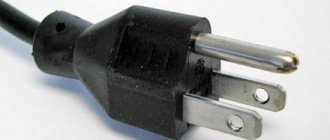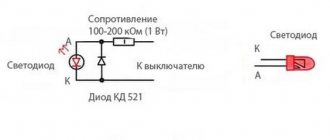Electricity, in particular electric lighting, is an essential part of our daily lives. It is difficult to find a room that does not have an electric light bulb. Cases often occur when some lighting fixtures in an apartment or house begin to blink. In addition to affecting the human nervous system and his vision, such pulsation of electricity can damage electrical appliances, lead to a short circuit and fire. If this problem occurs, you need to find out what is causing it and fix the problem. In many cases, you can do without calling an electrician.
Flashing light indoors
Warning!
But let us remember firmly: without the qualifications and skills of an electrician, without special tools and protective equipment, it is impossible to carry out work on ANY electrical equipment, including household electrical appliances! You can only use the standard controls without disassembling anything.
Electric shock will not warn you in advance, and its consequences are unpredictable and can be long-lasting. Especially if you have been drinking alcohol. Already from a shot of vodka, a person’s electrical resistance drops 1000 times, and an otherwise harmless pinch can turn out to be a fatal blow.
Precautionary measures
If a resident of an apartment is faced with the fact that the light is flashing and decides to deal with the problem with his own hands, one should remember the danger of electric current. If you lack skills and experience in working with electricity, and if there are no professional insulated tools, it is better to entrust the work to a highly qualified craftsman.
To carry out the work you should use:
- dielectric mats and gloves;
- tools with insulated handles;
- voltage indicators;
- protective glasses.
Current is invisible to the human eye, and many people are not afraid of it when they start repairing electrical appliances. The human body has its own resistance, which depends on many factors. It may change due to lack of sleep, high ambient humidity, alcohol consumption, nervousness and other cases in which it is prohibited to carry out work related to the electrical network.
Option 1: The light bulb in the stationary lamp is blinking
First of all, why are the lights blinking in the apartment? If one light bulb in a stationary lamp (or one section in a chandelier) blinks, then either it, or the switch, or the wiring section between them is faulty.
Let's listen to the switch, with a closer ear. Do you hear something like a faint crackling or hissing sound? If yes, bad contact. The switch, however, may be in good working order, but dirt has just gotten onto the contacts or into the spring. Unscrew the flashing light bulb and quickly click the switch several times. Please note - with the light bulb unscrewed, no load! Otherwise, the already weakened contacts may burn out, and the switch will completely deteriorate. Screw in the light bulb again. Did it help? If not, move on.
We replace the flashing light with a known good one. If there is no spare, temporarily unscrew it from somewhere. Is that how it blinks? Well, the problem is in the wiring or in the electrical fittings of the lamp. This is already the work of the master.
Other reasons
Sometimes the light may blink due to a breakdown of an energy-intensive electrical appliance. For example, the heating element of a water heating boiler can partially penetrate the grounded body, while remaining in operation. As a result of such a hidden fault, the voltage in the house becomes unstable and the light bulbs flicker. It is also possible that the electrical appliance is working properly, and the reason lies in a weak connection between the plug and socket contacts.
If the light in the room blinks at a frequency of 100 Hz (noticeable with peripheral vision), then the lamp is connected through a semiconductor diode. This is one of the ways to extend the life of a light bulb and save energy, used in corridor lighting. This flashing light is absolutely safe from an electrical point of view, but is contraindicated for vision.
Changes in the electrical network can be caused by a malfunction in the main section or transformer substation. In this case, the lights flash in all apartments and houses connected to this area. The solution to this problem should be handled by the local emergency power service.
The secret of the long blinking of lamps in apartments and houses located in the private sector is revealed simply. Carrying out welding work using an old-style welding machine leads to severe voltage drops in all nearby energy consumers. It happens that it is useless to prove to your welder neighbor that he is wrong. Then it is better to buy a powerful stabilizer that can protect all electronic equipment, and replace conventional light bulbs with LED ones.
If the house is lit exclusively by fluorescent and LED lamps, then power surges may go unnoticed. High-quality CFL and LED lamps operate stably at low (high) voltage. Flashing of an LED lamp can only appear in two cases: when it is turned on via a dimmer and in the absence of a built-in current stabilizer that maintains a stable glow at a network voltage below 200V. You can learn more about blinking LED lamps in this article.
Rising electricity prices make us think about saving. The first thing they do is change the lamps to energy-saving ones - compact fluorescent or LED. The decision is correct - the bills will be lower, but sometimes a problem arises: when the lights are turned off, the lights begin to blink. Why the light is blinking, how to fix it and we will figure it out.
Option 3 (global): The light flashes throughout the entire apartment
- Let's say there is at least one room in the apartment where the light does not blink . Then, most likely, the problem is in the “dose” - the distribution box inside the apartment. There is no need to go there yourself, but your information may be useful to an electrician.
- Flashes “the whole apartment? “We look out the windows. If it also blinks in neighboring houses, there is a fault at the substation or in the main supply cable - feeder. You need to inform the emergency utility service or directly to the power grid dispatcher - the number will be given at the help desk.
- Do the lights in neighboring houses burn smoothly? Let's look into the entrance - how is it there, is it blinking? Let's ask the neighbors. Is it flashing at everyone’s entrance? The feeder from the substation to the house is faulty, or the equipment of the input switchboard in the house or the electrical distribution network in it. Here you definitely need to inform the municipal emergency department - house electrical networks are under their jurisdiction.
- Finally, is it only yours that is blinking? Perhaps the fuse (plug) of your apartment in the electrical panel on the staircase is faulty. If it is available and there is a spare, you can replace it. But! If the shield is sealed, DO NOT OPEN it under any circumstances! There will be problems and sanctions with the energy sector later. And for the same reason – plus fire and electrical safety – DO NOT INSTALL A “BUG” CORK with a homemade wire fuse. A fire caused by a bug is a very common situation.
What to do if the wiring is faulty
If the wiring has not been changed for a long time, when you turn on household appliances, the light begins to flicker or the plugs are completely knocked out
. If, after all possible manipulations with the switch and light bulbs, the light continues to flicker, most likely, the electrical wiring in his home is of poor quality. A visual inspection of the distribution panel, in particular the wiring line that powers the lighting fixtures, will help verify this. It is important to carefully check the contact connections in the junction box itself. Typically, such problems arise due to a violation of the integrity of the conductors or when using aluminum wiring, which has low durability and strength.
In this case, there is only one solution - replacing the damaged area or all the wiring in the apartment.
Services providing and maintaining the home must be responsible for the quality and reliability of the services provided, as well as maintaining voltage within acceptable limits. At home, the optimal range ranges from 210-230 V.
However, unstable voltage is not always the result of poor quality services. The source of the problem may be residents of the house who turn on a large number of powerful appliances. Differences are also observed when starting devices equipped with electric motors. During reverse and startup, a network sag is observed.
Insulation problems
Sometimes the answer to the question “why is the light blinking” may not please you. One of the reasons is high leakage currents. In some cases, this is due to poor contact. This is easy to solve - clean the oxidized conductor, contact pad, tighten the bolt better, and re-solder the connection. It is not difficult.
But sometimes the flickering of the lamp is caused by deteriorated insulation. Somewhere it is damaged, as a result, part of the current “leaks away”. In practice, this is expressed precisely by the blinking of the lamps, their uneven glow. If there is a machine installed on the line, it often goes out “for no reason.” In fact, there is a reason, and it is poor wiring insulation.
The presence of a “breakdown” can be preliminarily assessed using a conventional multimeter. To do this, turn off the power (turn off the machine, the switch, unscrew the plugs), put the multimeter into dialing mode. We touch the exposed conductor of the problematic branch with one probe, and the wall, the ground loop, with the second. If there is a problem, you will hear the device beeping. This will mean that the insulation is broken.
Checking the breakdown of wire insulation using a multimeter
You will also need to check whether the wires in the cable are connected to each other. To do this, the probes touch each of the wires alternately (as in the figure above).
The exact size of the problem (how damaged the insulation is) can be determined using a megger, but this device is mainly in the arsenal of specialists, and the measurement itself will not yield anything. You will still have to change the wiring, since if the insulation breaks down, it is unsafe.
How do switching power supplies affect the quality of LED lighting?
All modern household appliances include a UPS. Their operating principle is based on converting 50 hertz household voltage into a high-frequency signal, followed by its rectification and further processing.
This high frequency from the equipment must be filtered by capacitors and chokes built into the unit. But in some situations they may not cope with this task or be damaged.
Then the induced high-frequency signal, for example, from a switched-on microwave, digital TV or other equipment, will penetrate the household network and create high-frequency interference.
They will also affect the operation of the LED lamp driver, which will be especially noticeable on models that use a resistive-capacitive voltage divider or a simple transformer conversion.
It’s easy to check the pickup of high-frequency pulses from equipment in your apartment: just turn them off. But this technique may not work when interference comes from neighbors or the network.
Here it is best to evaluate the quality of the supply voltage sinusoid with an oscilloscope, but this is an expensive test.
How does low mains voltage affect LED flickering?
The same principle applies here as with a “dead battery” that will not work for a long time. Any power driver is created for operation in a certain operating voltage range and has some kind of reserve.
Expensive models have a larger reserve, while budget models have a limited or even underestimated supply. This must be taken into account.
Poor-quality power supply with amplitude drops is especially typical for residents of rural areas with long overhead power lines.
This is a harsh reality, but it can be corrected. I specifically outlined how to increase the low network voltage to 220 volts in a private house in a separate article. Read there.
For the LED lamp to work properly, it is necessary to provide it with optimal power. Therefore, I recommend starting the repair process and finding the location of the fault by checking its value.
The level should be within 207÷253 volts. Moreover, at lower values, low-quality drivers may no longer work unstable.
Common cause: LED light switch
Often the answer to the question “why does the light blink when the lights are off” is a switch with LED backlighting. This “disease” is typical for compact fluorescent lamps (energy-saving) and some LED lamps (cheap). This is due to their device. The fact is that these lamps operate on a voltage of 12 V. So that they can be installed in 220 V lamps, a voltage converter is built into the base of these lamps. It contains a starting capacitor on which a charge accumulates, which “ignites” the glow of the lamp when it is turned on.
Compact fluorescent lamp design
In order to understand why the light bulb blinks when the LED-backlit switch is turned off, we also need to consider how such a switch is designed. The backlight is turned on in parallel with the key. It consists of an LED and a low-power resistor (see the diagram below).
Lighting diagram, if the switch has a backlight
When the light is turned off, the key breaks the power supply circuit of the chandelier, but current flows through the backlight circuit. It is very small and its size is not enough to normally charge the starting capacitor in the lamp converter. But gradually a certain charge accumulates on the capacitor, from which the process of “starting” the lamp begins. Since the charge is clearly insufficient, only after flashing does the lamp go out. Then the process is repeated again - the charge accumulates, the lamp flashes, goes out... This is the most common reason for blinking energy-saving and LED lamps.
Remedies
There are several ways to solve the problem of blinking energy-saving and LED lamps when the switch with LED backlight is turned off:
- Install a switch without backlight. The problem will disappear.
- Screw one low-power incandescent lamp (25 W, for example) into the chandelier. Often this solution helps, since the current is used to heat up the filament of the lamp, but the current is so small that the filament does not even change color in the dark.
- Remove the LED backlight in the switch. There will be no capacitor charging circuit - the problem will disappear.
When the lamp flashes for a moment and goes out... not the most pleasant thing
- Increase the resistance in the backlight LED power circuit. In this case, the current in the backlight circuit becomes so small that the starting capacitor is not able to accumulate a charge sufficient to start the lamp.
- Connect a circuit with lower resistance in parallel with the lamp/chandelier. The backlight current will flow through a circuit of lower resistance, bypassing the lamp. The problem will be solved.
There are usually no problems with replacing a switch: unplug the old one and install a new one in its place. But the other three methods are worth explaining in more detail.
Changing the parameters of the backlight LED power circuit
In backlit switches, it can be organized in two ways: using a board on which an LED and a mini-resistor are mounted (more expensive models) and connecting a regular resistor and an LED in parallel. It's too difficult to tinker with the board - it's very small. In this case, it is easier to remove it by getting rid of the backlight. In the second option, you can replace the resistor with a more powerful one, which will reduce the current flowing through the capacitor and will not allow charge to accumulate. There is another possibility - to unsolder this backlight. The problem will also be solved.
The power of the resistor is selected depending on the type of lamp used for illumination:
- with a neon bulb set the resistance to 220 kOhm:
- with LED there are two options - 470 kOhm or 680 kOhm (determined empirically).
Alteration of the switch to eliminate lamp blinking
For normal operation of the circuits, an IN4007 diode is added to the circuit between the resistance and the backlight lamp, the cathode to the resistor. It is more convenient to first assemble the circuit on the table, then solder it to the old place. After this modification, the lights will stop blinking.
Why the light bulb blinks: eliminating the cause
How to do all this? Disassemble and disconnect the switch from the network, find the backlight circuit (on the back of the switch). We solder this circuit, replace the resistor, install a diode, and solder the LED. When working, you need to solder quickly and carefully - if overheated, the LED may be damaged. Also make sure that the LED remains in approximately the same place so that the backlight is clearly visible. We solder the assembled circuit into place, connect it and put the switch in place.
We connect a low resistance circuit in parallel with the chandelier
To ensure that the currents flowing through the backlight do not accumulate on the starting capacitor, a circuit with low resistance is installed in parallel with the lamp. Currents will flow through this circuit, the light bulb will stop blinking (the modification diagram is below).
Another way to eliminate the flickering of an energy-saving lamp
To operate, you will need a resistor with a nominal resistance of 50 kOhm and a power of 2 W. We solder the conductors to its outputs (to make it easier to connect), and carefully insulate it. Correctly insulate as follows: first apply thinner heat shrink to each soldering point, then put a larger diameter heat shrink tube on top, closing the resistance housing.
It is important to do everything carefully and correctly
The resulting chain must be connected in parallel to the lamp. This can be done in the junction box (this is the right solution), or it can be done directly to the chandelier (the worst option).
There is another solution - use a capacitor instead of a resistor. Its characteristics are 0.47 µF, 400 V. It is also connected in parallel to the lamp (preferably in a junction box). The solution is more universal (works with most LED lamps), but less common.











